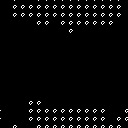This is Conway's version of Game of life. Made as an assignment for Concurrent Computing.
The simulation is designed to work on xCORE-200 eXplorerKIT. Some of the core features are parallel programming, synchronization and bit-packing.
The simulation is written in XC.
There are 6 available boards/pictures - 16x16, 64x64, 128x128, 512x512 and 1024x1024.
Upon F13 button press, the program will distribute the the board within 4 or 8 "workers" working on
different threads.
It includes:
- Button Listener
- Orientation Listener
- LED trigger
- Synchronised thread communication using channels
 -----64x64, 100 Iterations, Time taken:6020 miliseconds---->
-----64x64, 100 Iterations, Time taken:6020 miliseconds----> 
 ---128x128, 100 Iterations, Time taken:17935 miliseconds--->
---128x128, 100 Iterations, Time taken:17935 miliseconds---> 
Beneficial factors:
- Direct parallel communication between workers, so that they don’t trigger a deadlock.
- Packing of 8 cells into a single byte (bit packing) within DataInStream()
- Minimal data transfer across the workers and the distributor
- Workers working synchronized
Limitations:
- The number of tiles: with more tiles we could have more workers processing in parallel
- The need for data transfer between distributor and workers whenever a data export is requested
- We have multiple ideas on how to improve the program that we couldn’t try due to time restraints: The data can be compressed even more by grouping clusters together into a “word” and then encoding that word into an ASCII character. That way, even though we would have to save a dictionary for the different encodings, that dictionary would still take less space in processing larger images. This scheme would work very similarly to the LZW compression used in compressing files.
- We can disable and reassign workers that are processing empty (dead) sections of the board. We can decide which workers may need reassigning using previously gathered board data.
- We experimented with storage in the nextGen function. We could replace multiple integer values representing the cells surrounded the current cell, by a single value that simply accumulated the number of alive cells that surrounded the current cell.